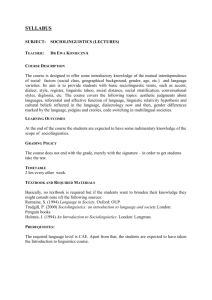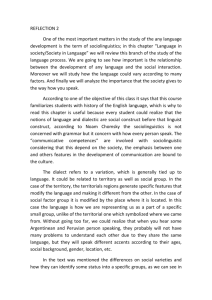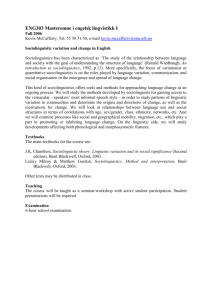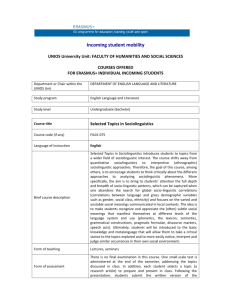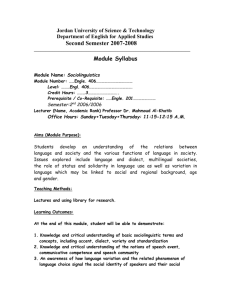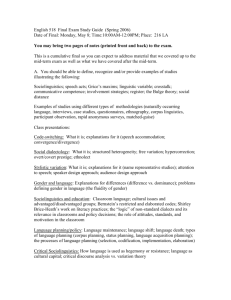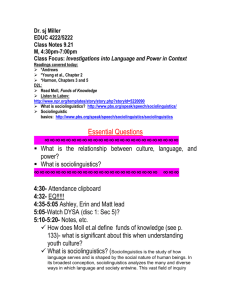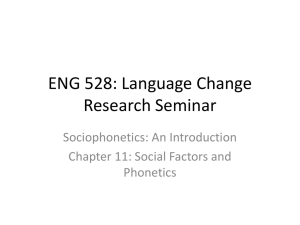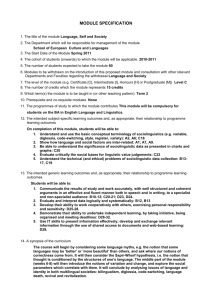Paper Citizen Sociolinguistics: The Return of the Repressed
advertisement
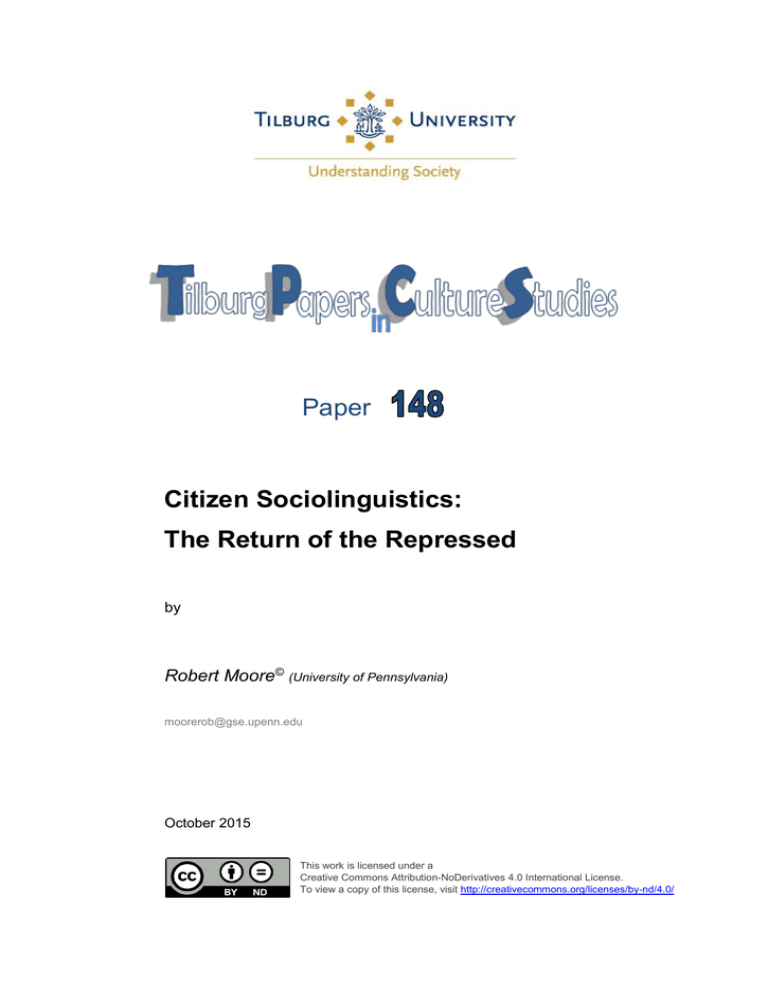
Paper Citizen Sociolinguistics: The Return of the Repressed by Robert Moore© (University of Pennsylvania) moorerob@gse.upenn.edu October 2015 This work is licensed under a Creative Commons Attribution-NoDerivatives 4.0 International License. To view a copy of this license, visit http://creativecommons.org/licenses/by-nd/4.0/ 1 Citizen Sociolinguistics: The Return of the Repressed Robert Moore University of Pennsylvania Relationships between linguists and speakers of languages have been complex over the whole modern period. Aside from the obvious one-way dependency—linguists need speakers; the reverse is in no obvious way true—there are deeper paradoxes, perhaps chief among them the principle that speakers need to be heard (in phonetic detail), but not heard from. Citizen Sociolinguistics is located right at the interface between the expert discourse of sociolinguistics developed by (and mostly for) academic researchers, and popular discourses about language variation developed by and circulated among ordinary citizens; further, it tries to trace the way that terms, concepts, discourse genres, texts, and even people circulate back and forth across that permeable boundary. This last task is made easier by the very design and affordances of online social media platforms (more on this below). Citizen Sociolinguistics, in other words, takes seriously and examines closely the kind of material that modern sociolinguistics has made elaborate efforts to sidestep, ignore, or short-circuit: it seeks to develop new methods of gathering and analyzing the massive amount of freely available data from the internet in which “everyday people compile detailed illustrations of and commentaries on” their own and others’ uses of language (Rymes & Leone 2014). Thus, Citizen Sociolinguistics as an approach to research marks a fundamental break with the epistemic project of traditional sociolinguistics, particularly that of variationism and language attitude research. In the Martha’s Vineyard study, for example, Labov gave advice on how to select a (phonological) variable for study. First, a good variable should be one that is of frequent occurrence; second, it should be “structural”—“the more the item is integrated into a larger 2 system of functioning units, the greater will be the intrinsic linguistic interest of our study” (Labov 1972: 8); third, its distribution in the speech community “should be highly stratified ... [and display] an asymmetric distribution over a wide range of age levels or other ordered strata of society” (ibid.). But—Labov continues: There are a few contradictory criteria, which pull us in different directions. On the one hand, we would like the feature to be salient, for us as well as for the speaker, in order to study the direct relations of social attitudes and language behavior. But on the other hand, we value immunity from conscious distortion, which greatly simplifies the problem of reliability of the data (Labov 1972: 8). So the phonological feature selected for study should be salient to speakers—but not so salient that speakers have ideas of their own about it. In any case it is clear that “immunity from conscious distortion” is not easily gained. In a footnote attached to the above passage, Labov notes that Many ingenious devices are needed to detect and eliminate deceit on the part of metropolitan informants, whether intended or not. On Martha’s Vineyard, this is less of a problem, but the effects of the interview situation are evident in the careful style of some informants (Labov 1972: fn 13 at p. 8). Obviously we are discussing what Labov called “the classic methodological problem: the means used to gather the data interfere with the data to be gathered” (Labov 1972: 43). “Our goal,” says Labov, “is to observe the way people use language when they are not being observed” (1972: 61). It’s for this reason, of course, that Labov placed such high value on “rapid and anonymous observations,” such as those of his famous investigation of the (r) variable in New York City department stores (1972: 69). In his well-known discussion of “the observer’s paradox,” Labov recommended the use of “various devices which direct [the speaker’s] attention away from speech, and allow the vernacular to emerge,” including the “Danger of Death” technique, in which speakers are asked to narrate a near-death experience. Such devices, it is argued, induce in the speaker “a shift of style away from careful speech towards the vernacular” (Labov 1972: 209-210). 3 It was in exactly this spirit that Howard Giles and other researchers interested in language attitudes held the matched-guise technique in such high esteem. Matched-guise testing “involves the presentation [to subjects] of tape-recorded voices of one speaker reading the same factually-neutral passage of prose in two or more dialects or languages” (Giles 1971: 211). Just as ‘the vernacular’—that obscure object of variationist desire (see Coupland 2003, Eckert 2003)—is seen as lurking in the inner recesses of the speaker, requiring for its expression “devices” that short-circuit the speaker’s self-censorship and “conscious distortion,” so too the elicitation of “language attitudes” becomes complicated, and “assumes greater intricacy since such evaluative reactions are concomitantly dependent on a complex matrix of sender-receiver attributes including age, sex and social status” (Giles 1971: 211). Lambert et al. (1965) had claimed that “standard measures of attitudes” produced data inferior to that produced by matched-guise experiments, for the precise reason that the purpose of the data-gathering activity was “often ‘transparent’ [to the subjects] and is thus conducive to socially-appropriate responses, whereas the true nature of the former technique [matched-guise testing] is unlikely to be detected and in this way undistorted attitudes may be evoked” (Giles 1971: 213). This led Lambert to suggest that “the matched-guise technique was a more efficient instrument ‘for evoking “private” or “uncensored” attitudes’ towards a particular social group” than other more straightforward methods (ibid.). What Labovian variationism shares with language attitudes research is a commitment to that hallmark of modernism in scientific praxis: operationalism (Bridgman 1927). In both literatures, speakers are recategorized as experimental subjects. Hence my title. The emergence of Citizen Sociolinguistics heralds the return of the repressed: The artist formerly known as the Speaker reappears—but this time neither as a naïve “native” speaker (perhaps induced into a state of maximal un-selfconsciousness by the researcher’s deployment of elicitation “devices”), nor as the passive bearer of an internalized 4 linguistic competence, nor as an experimental subject, nor as a cultural dope (Garfinkel 1967)—rather, as a Citizen Sociolinguist, well able and inclined to articulate variously systematic or “anecdotal” ideas about language (and specifically about facts of sociolinguistic variation). To evaluate these statements, stories, performances, expressed opinions, and parodies for their “accuracy” vis a vis some sociolinguistic reality to which ‘we’ (linguists) have independent (and superior) access is to make a category mistake. The material will not allow that—Citizen Sociolinguists are unreliable narrators. Sweeping generalizations, tendentious claims, pseudo-expert posturing and downright prejudice are all richly on display in online discussions of such matters as ‘accent’. But these “biases” become virtues once we ask not about the accuracy of ordinary people’s metacommentaries on language, but about the conventions governing their production and reception, and the performative implications of the act of expressing them—which is to say, the conditions under which they become effective (and, perhaps, worth “liking” or “sharing”). Now it becomes important to note that what’s interesting about the “ordinary people” whose observations of and comments on language form the data of Citizen Sociolinguistics is not their ordinariness, but the fact that they can be observed online functioning in roles usually associated with university-based experts, becoming active chroniclers of socially meaningful variation in the language(s) they use and hear around them, even engaging with the discourse (and the data-gathering procedures) of sociolinguistics as an academic discipline. As a cultural phenomenon, Citizen Sociolinguistics bears witness to the circulation and uptake of erstwhile expert discourses about language in settings apparently far removed from universities and other institutions where these expert discourses originated. And this process of circulation is itself aided by the very same communication technologies where Citizen Sociolinguistics lives. 5 To interpret the metapragmatic import (illocutionary force, if you like) of any utterance act in any medium, one must always attend first to its uptake in the event: what happened next? It is in the uptake that we discover whether the just-preceding speech act satisfies its ‘felicity conditions’ (Goffman 1983). Online discussions, in which it’s not only possible but easy to react to, respond to, re-circulate, and otherwise (explicitly or implicitly) evaluate another’s utterance, provide rich attestations of uptake in exactly this sense (Goffman 1976). And the traces of all such intertextual response chains—and the origin, growth, and decline of particular examples, words, and phrases (e.g., as memes)—are open to investigation (see Nie 2015 for an exemplary study of just this type). In fact, particular online platforms and services (Facebook, Twitter, etc.) do not only develop their own conventions and styles of such metapragmatic uptake through evaluation (e.g., “likes”), recirculation (e.g., retweets), and re-animation—conventions and styles that experts transmit to novices in “socialization” moments—they also become environments in which expertise is displayed primarily through performed mastery of “stylized” uptake (aka ‘curation’). Such online communities, constituted in and by collaborative participation in discursive activity, share many characteristics with ‘publics’ in the sense of Warner (2002): participants experience mutuality of uptake in an environment of stranger sociability. Online, participants interpellate each other using screen-names and avatars, and calibrate their mutual availability through adopted personae (often many for each user; see Manning 2013). Unlike dialectology and in contrast to variationist studies of language change in progress, the ultimate goal of Citizen Sociolinguistics is not to study variation as a way of understanding larger processes of language change, but to focus on the circulation and exchange of samples of observed speech and metacommentary upon them as a social activity in its own right, one that is centrally constitutive of non-face-to-face online communities. 6 Users of social media who participate in online discussions of ‘accent’ or ‘dialect’ know that they are being observed. The “devices” that enable the expression of citizens’ views of sociolinguistic variation are given, in the form of the digital infrastructures of various social media platforms (and the actual devices people use to access them). The means used to gather the data are identical with the means used to produce the data. Anxieties about the “observer’s paradox” disappear when we re-orient ourselves to interpreting—and contributing to—publicly available forms of expertise and the technological means for their expression, re-signification, and circulation. 7 References Coupland, Nikolas. 2003. Sociolinguistic authenticities. Journal of Sociolinguistics 7(3): 417431. Eckert, Penelope. 2003. Elephants in the room. Journal of Sociolinguistics 7(3): 392-397. Giles, Howard. 1971. Evaluative reactions to accents. Educational Review 22(3): 211-227. Goffman, Erving. 1976. Replies and responses. Language in Society 5(3): 257-313. Goffman, Erving. 1983. Felicity’s condition. American Journal of Sociology 89(1): 1-53. Labov, William. 1972. Sociolinguistic Patterns. Philadelphia: University of Pennsylvania Press. Lambert, W. E., Anisfeld, M. & Yeni-Komshian, G. 1965. Evaluational reactions of Jewish and Arab adolescents to dialect and language variations. Journal of Personality and Social Psychology 2(1): 84-90. Manning, Paul. 2013. Altaholics anonymous: On the pathological proliferation of parasites in massively multiple online worlds. Semiotic Review, Issue 1: Parasites. http://www.semioticreview.com/pdf/parasites/manning_altaholicsanonymous.pdf Nie, Ted. 2015. The viral spread of “duang.” Tilburg University (Netherlands): ms. Rymes, Betsy, and Andrea Leone. 2014. Citizen sociolinguistics: A new media methodology for understanding language and social life. Working Papers in Educational Linguistics 29(2): 25-43. Warner, Michael. 2002. Publics and counterpublics. Public Culture 14(1): 49-90.

